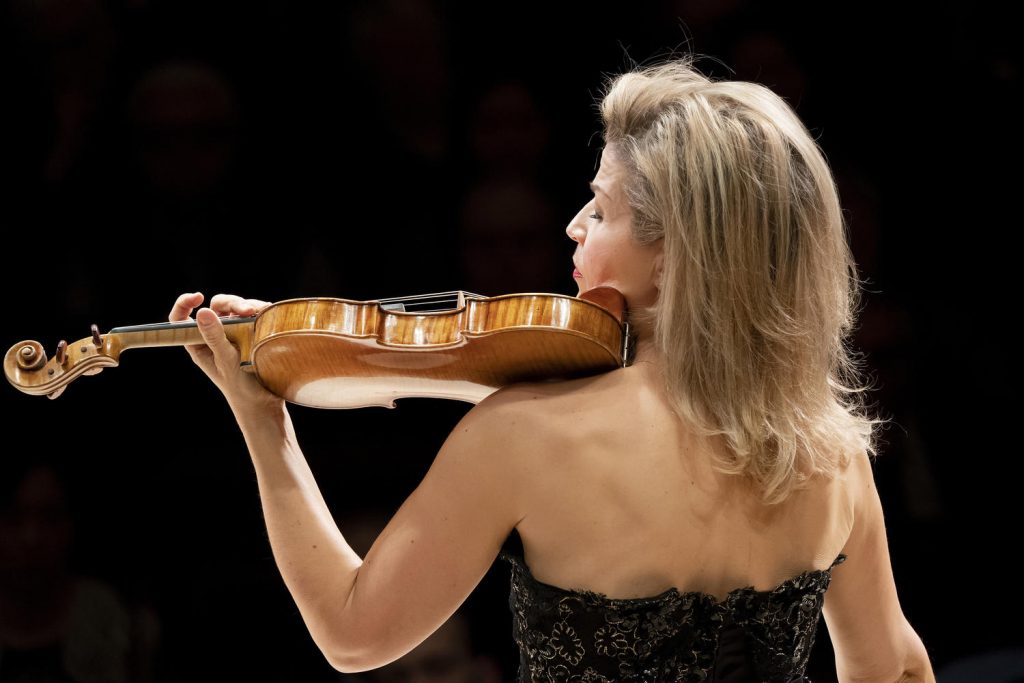Mutter and Friends set Beethoven 2020 birthday festivities in motion at Carnegie

The great bassist and composer Charles Mingus usually didn’t hand out sheet music to his band. Instead, he would play each part from the piano until everyone could play them back. The musicians skipped over the process of reading notation and, with everything deep in their ears and fingers, went straight to making music together. Mingus’s bands had a sound that felt loose though everyone was absolutely coordinated, and it was incredible.
That sound, such complete knowledge and command of a composition so that it feels both skillful and off-hand — an intuitive virtuosity that is no longer reading or interpretation but is music-making in the extemporaneous sense — is rare in classical music. Classical ensembles tend to have a more indirect, and often more anxious, relationship with composers and their scores.
One exception is violinist Anne-Sophie Mutter, who always seems to be in Mingus territory. Thursday night she launched Carnegie Hall’s Beethoven celebration with playing that was so natural, so much in her ears and her hands, that the deeply familiar seemed to spin with a feeling of extemporaneous discovery.
The billing in Stern Auditorium was for “Anne-Sophie Mutter and Friends,” in this case pianist Lambert Orkis and cellist Daniel Müller-Schott. With Orkis, Mutter played Beethoven’s Sonatas for Piano and Violin No. 5, “Spring,” and No. 9, “Kreutzer,” as bookends, and in between, joined by the cellist, the Op. 70, No. 1 “Ghost” Piano Trio.
What Mutter does with the violin is unsurpassed. More than even technical command, she has expressive command — there are the notes, and there is what she does with them. As much as one anticipates enjoying her playing, there is no way to expect how it will sound.
The first movement of the “Spring” sonata set a tone that went beyond the usual experience of even top-level performances. Beethoven willfully shoves several themes together into what the theory books supposedly say is sonata-allegro form. Yes, it’s a sonata and the first movement is marked Allegro, but the essential thing is that its music that a violinist and pianist play together, finding meaning and excitement in the phrases.
Mutter, with Orkis a propulsive partner, took these phrases and played them without regarding the form: here was a line, here was a line, here was another. Sections, repeats, a double-bar line were inconsequential, what mattered was how a melody sounded as it floated off the strings. The “Spring” sonata scherzo wasn’t an outline of Beethoven’s astonishing, syncopated rhythms, it was Mutter and Orkis tossing notes at each other like it was a game and the winner was the one who avoided the downbeat the longest. Both musicians played the “Kreutzer” with near-violent energy, attacking the fast music with cutting accents, while the Andante con variazioni had an inward-looking poise.
Each time an idea returned, Mutter played it with a different articulation. She added small, acute touches of portamento, and in both sonata performances drew a contrast between plain-spoken passages and vibrato-heavy sustained notes. This was all on top of her usual way of varying color and timbre depending on the personal meaning she finds in different parts of the music.
The simple word for this type of instrumental playing is “vocalized,” and this was a concert in which her violin sang. But there was more to it than that; it was like an actor fully in character delivering the lines of a great playwright. What are typically musical narratives — how do we get back home from where we are — became story-telling. On Thursday it was about the journey, not the destination.
Müller-Schott fit right in for the “Ghost” trio. Mutter played the sonatas from memory, and had music on the stand in front of her for the trio, but that in no way inhibited the naturalness of the playing.
There was excellent bounce to the first and third movements — no matter from what period of his life, Beethoven’s music always has a strong kernel of youthful energy in it. The famous slow movement that gives the piece its moniker may have been fast for some listeners the tempo was close to Andante — but this felt right for what the musicians were playing. It’s easy to ascribe tragedy to the music after the fact, but it’s appropriate to hear it, and play it, as something thoughtful, a moment of repose and even doubt from which to recover.
This was Beethoven without melodrama and free from the accumulated sediment of seriousness that’s often laid on top of him. The music is full of life, and the experience of living, and Mutter and her friends played it with their own joy and humanity.
Carnegie Hall’s Beethoven celebration continues 8 p.m. February 19 when John Eliot Gardiner and the Orchestre Révolutionnaire et Romantique begin a complete symphony cycle. carnegiehall.org/beethoven; 212-247-7800.


